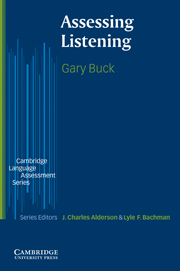Book contents
- Frontmatter
- Contents
- Series Editors' Preface
- Acknowledgements
- 1 An overview of listening comprehension
- 2 What is unique to listening
- 3 Approaches to assessing listening
- 4 Defining the construct
- 5 Creating tasks
- 6 Providing suitable texts
- 7 Designing and constructing complete assessments
- 8 Illustrative tests of listening comprehension
- 9 Summary and future developments
- Bibliography
- Index
- Frontmatter
- Contents
- Series Editors' Preface
- Acknowledgements
- 1 An overview of listening comprehension
- 2 What is unique to listening
- 3 Approaches to assessing listening
- 4 Defining the construct
- 5 Creating tasks
- 6 Providing suitable texts
- 7 Designing and constructing complete assessments
- 8 Illustrative tests of listening comprehension
- 9 Summary and future developments
- Bibliography
- Index
Summary
Introduction
In Chapter 3 I discussed some of the most important historical ideas in language testing, and described the techniques that have commonly been used to test listening comprehension. I also discussed the constructs implicit in those common practices. In this chapter, I will discuss what should be the first stage of test development: defining the construct.
When we make a test, we do it for a particular purpose and for a specific set of test-takers, and these form the starting point for test development. The first step is defining the construct. This is a two-stage process: firstly, we define it on a theoretical or conceptual level, and then secondly, we operationalise that through the texts we select, and the tasks we ask our listeners to perform. The conceptualisation of our listening construct will be based on both our theoretical understanding of listening comprehension, and from our knowledge of the target-language use situation. The operationalisation of the construct will be based on our knowledge and experience as test-developers. Operationalisation of the construct could be inadequate for two reasons: we could omit something that should be there, or add something that should not. Messick (1989, 1994) has provided two useful terms for these: construct-underrepresentation, which occurs when the operationalisation of the theoretical construct is incomplete and parts of it are not represented in the test, and construct-irrelevant variance, which occurs when the test assesses abilities which are not included in the theoretical description of the construct.
Information
- Type
- Chapter
- Information
- Assessing Listening , pp. 94 - 115Publisher: Cambridge University PressPrint publication year: 2001
